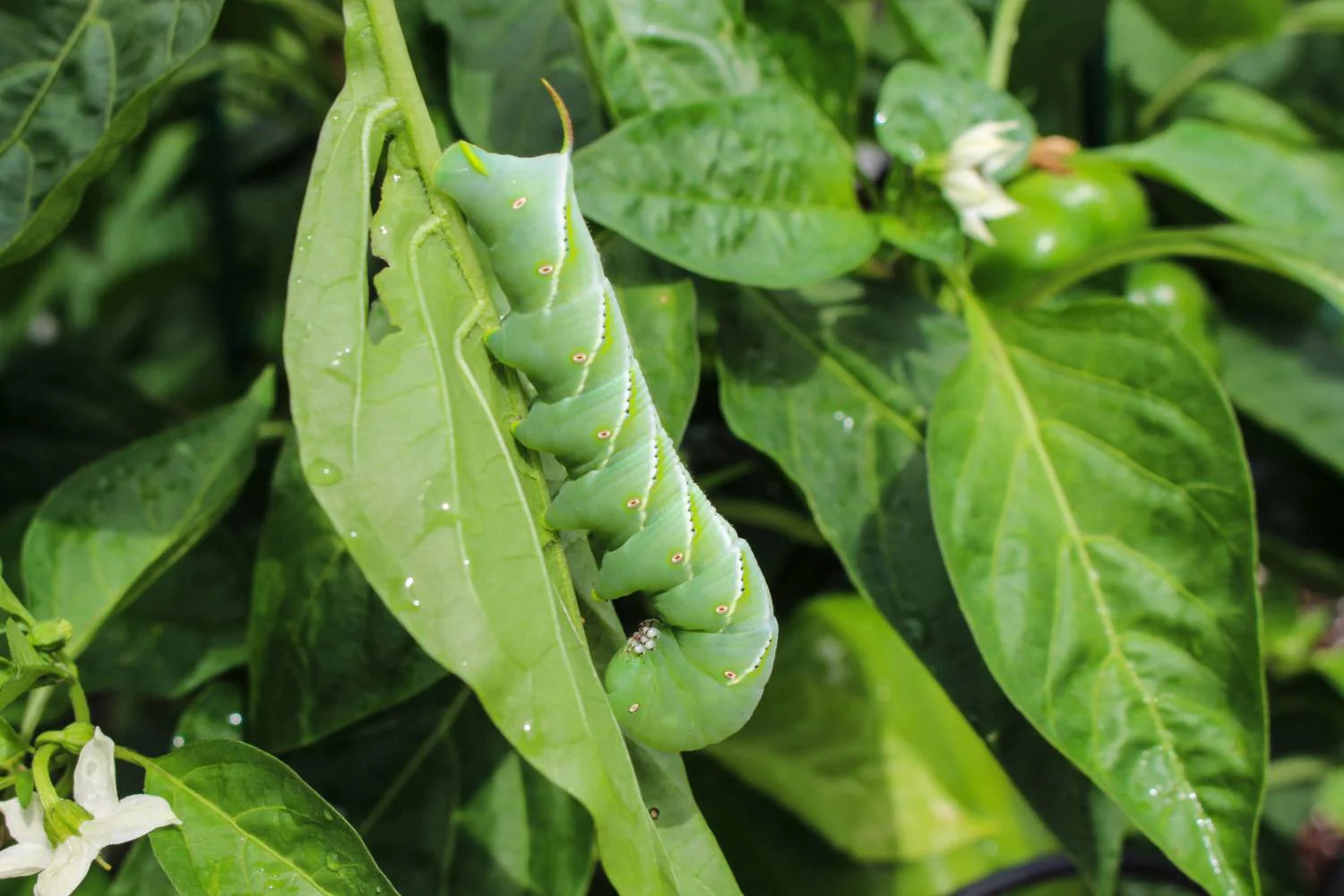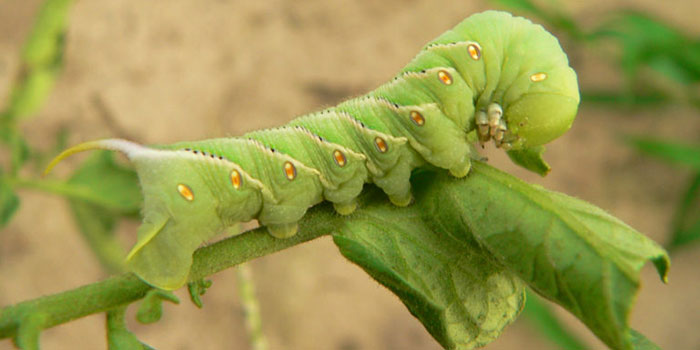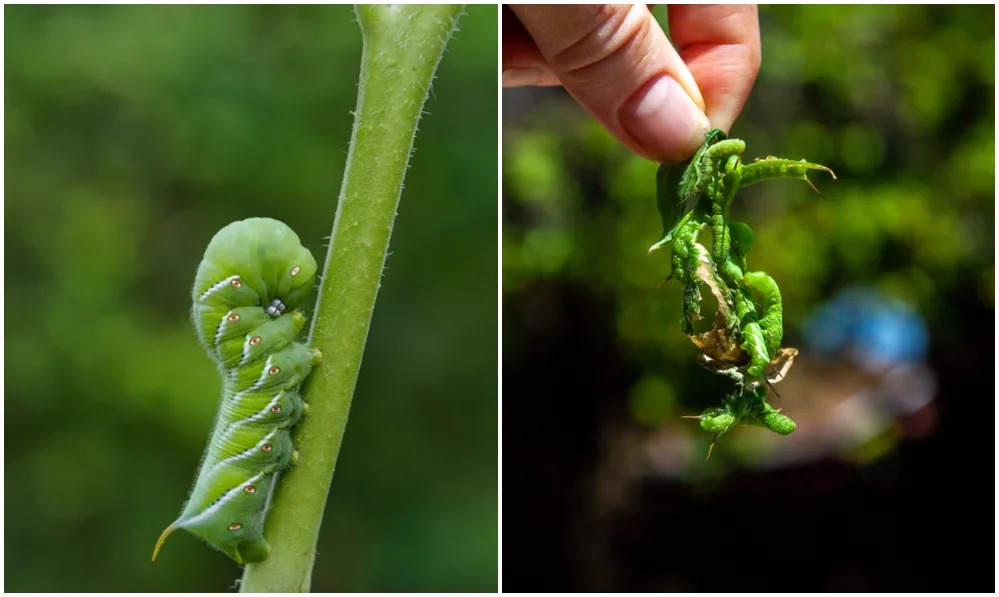Hornworms: How To Prevent and Get Rid Of Them
Hornworms can be a formidable threat to your garden, particularly to plants in the nightshade family such as tomatoes, peppers, and eggplants. These large, green caterpillars can quickly devour foliage and wreak havoc on your beloved plants. However, with proper prevention and effective control methods, you can successfully combat hornworm infestations and protect your garden.
What Are Tomato Hornworms?
Tomato hornworms are large green caterpillars that are approximately five inches in length and have red or black spikes coming out of their tail. They feed on the foliage, stems, and fruits of different plants in the nightshade family, including tomato plants, peppers, tobacco, potato, and eggplant crops.
The presence of tomato hornworms can quickly cause a great deal of harm to crops by eating off large amounts of foliage in a short amount of time.
These pests are native throughout North America and Australia so it's important for gardeners to be vigilant about examining their plants for early signs of infestation before it becomes too severe.
How to Identify Tomato Hornworms
Tomato hornworms are one of the most common pests found in home gardens. They look like a large green caterpillar that measure about four inches long on average, with seven white v-shape stripes running diagonally along their bodies. The defining feature of these pests is the large red or black horns that protrude out of their rear.
When they reach adulthood, they turn into a moth with a five-inch wingspan and a dull gray color instead of being bright green as they were when they were larvae. The best way to identify them is by their color - a perfect match to tomato leaves to ensure nothing else blends in with the plants as well as these do.
It should be noted that other caterpillars may be found in tomato plants but unless they have that telltale coloring and horns, it’s not likely to be Tomato Hornworms.
Tomato Hornworms vs. Tobacco Hornworms
Tomato hornworms and tobacco hornworms are two species of insects from the same family, making it easy to confuse them. They both have a distinct caterpillar shape, with v-shaped white stripes and a black colored horn on their back.
Although you may not necessarily need to distinguish between the two, it is important to know the telltale difference — the tobacco hornworm has a red-colored horn and diagonal white stripes instead of v-shaped ones.
Understand the Tomato Hornworm Lifecycle
Gardeners can benefit from understanding the complete lifecycle of tomato hornworms, which consists of four distinct stages. Although the most noticeable and damaging stage is the larvae stage, there are important developments occurring before and after that phase that are not commonly observed. Knowing these stages can help gardeners manage these pests effectively.
Eggs
Eggs are essential to the life cycle of many species, including that of the sphinx moth. The female adults lay their eggs in the nightshade family of plants, including tomatoes, peppers, eggplants, and potatoes.
This highly specialized behavior ensures that the larvae will have a nutritious food source after they hatch. Despite being small and fragile when first laid, these eggs hatch within three to five days and develop into caterpillars with voracious appetites.
Larval Stage
Most gardeners are familiar with the larval stage of the tomato hornworm. This is an often unwelcome stage, evidenced by finding a huge, fat, green worm on your beloved tomato plants. What most don’t realize is that this pest has a five-instar life cycle and hasn’t even hit its adult form yet.
Its larval stage usually lasts about three weeks and can reach up to five inches in length and 10 grams in weight. That’s a lot of added baggage for your plants!
Pupae Stage
The pupae stage of the tomato hornworm’s life cycle is an important transitional period before the insect emerges as a fully-grown moth. During this time, the caterpillar undergoes yet another transformation, encasing itself in a reddish-brown cocoon.
Inside, the caterpillar will be dormant for an extended period, waiting until it’s ready to break free again and morph into its adult form.
After overwintering in cocoons buried in soil during cold weather, spring warmth causes these pupae to become more active. As they near full maturity, they beat their wings inside the cocoon and use pheromones to attract their potential mate.
Adult Hornworms
The tomato hornworm’s lifecycle concludes with the adult stage. As late spring approaches, the pupae hatch, yielding a large moth commonly known as the five-spotted hawk moth or the sphinx moth.
This species feeds on nectar of different flowers in the morning and evening, but is difficult to spot during daylight due to its nocturnal habits. During this stage, these moths also lay eggs which are responsible for continuing the existing lifecycle all over again.
It is worth noting that since it often treats our gardens like a buffet, the adult version of the tomato hornworm can cause major destruction to crops and flowers across gardens throughout summer months when in full growth.
Damage Caused by Tomato Hornworms
Identifying tomato hornworms on plants can be challenging for gardeners since the pests tend to blend in with the plant's color. Moreover, the signs of tomato hornworm infestation can be easily mistaken for those of other pests. However, there are some indications that gardeners can look out for to confirm if the damage is caused by these worms.
Black Droppings
Black droppings on plants can be a serious issue for gardeners and homeowners alike. They are most commonly indicative of the presence of destructive hornworms, which are voracious feeders that destroy entire parts of plants with their sharp mandibles.
The droppings left behind by these caterpillars on the leaves are black and easily visible, allowing people to quickly identify if their plants have been affected.
In addition to being symptom of an ongoing problem in gardens, these black droppings can make even healthy plants look unappealing - not only does this impact aesthetics but continued infestation could also cause significant yield reduction or crop loss.
Check in The Evenings
It's important to take the time to check your plants in the evenings and at night for signs of tomato hornworms. These pests are most active at dusk, dawn, and during the night as they come out to feed on your plants.
While their camouflage-like colors can blend in with the leaves making it harder for you to spot them, their activity does give them away. To make sure you have a better chance at spotting these pests, bring a flashlight when you go to inspect your plants in the evening or late at night.
Large Holes in the Plant Leaves
Tomato hornworms can quickly and easily wreak havoc on your garden. Known for their large holes, they are often spotted plucking away at the leaves of tomato plants or other varieties in your garden.
They feed superficially and have no difficulty stripping every bit of plant matter from the leaves, leaving large holes as evidence of their behavior. If left unchecked they can cause extensive damage, eating all of the leaves rather than just some spots, thereby defoliating entire plants.
How to Get Rid of Tomato Hornworms Naturally
Gardeners don't necessarily have to rely on chemical treatments to eliminate tomato hornworms from their plants. Natural and organic methods can be highly effective, especially if the infestation is not yet severe.
By adopting these methods, gardeners can ensure that their plants remain free of harmful chemical residues while also protecting the environment.
Till The Soil
Tilling the soil can be a very divisive topic nowadays. Some people choose to use traditional methods of tilling in order to prepare a suitable environment for their plants or crops, while others are turning towards no-dig gardening techniques.
One of the biggest issues with tilling is the disruption it can cause to beneficial insects such as butterflies, who lay their pupae in the soil during winter months.
When you till the soil, you are essentially exposing these pupae to extreme temperatures which causes them to die before they have chance to hatch and become adults, reducing biodiversity and insect populations in your garden or agriculture plot significantly.
Hand Pick Tomato Hornworms Off Your Plants
Handpicking tomato hornworms off your plants is a great way to get rid of them naturally without using any pesticides. While likely not the most pleasant task in the gardening world, it’s important to inspect your plants once or twice every day to make sure you can spot these pests before too much damage is done. I recommend wearing gloves for this, as these worms can be rather unpleasant to touch!
Use Companion Planting
Companion planting is an incredibly useful technique for gardeners to use in order to keep pests at bay, such as tomato hornworms. Companion plants have a mutually beneficial relationship with the vegetables they are planted near.
For example, basil repels tomato hornworms while simultaneously improving the flavor of the tomato fruits and inviting helpful pollinators like bees and butterflies. Borage also helps to deter these pests while attracting many beneficial bugs that can help protect your vegetable garden from attacks by insects.
Plant Trap Crops
Trap crops can be an effective way to protect gardens from pests. Trap crops are planted near infested plants, but far enough away that they serve as a lure for the pests. This can effectively divert their attention away from the plants you’re trying to protect, providing an easy and sustainable solution.
When it comes to hornworms, planting flower tobacco plants is an effective trap crop. Flower tobacco is attractive to the sphynx moth and has been proven in studies to be the best plant for these pests. What’s more, it’s not harmful to beneficial insects, making it a great choice if there are other beneficial species in your garden.
Rotate Crops
Rotating crops is a great way to reduce populations of hornworms in the garden. By rotating the crops grown in a specific garden each season, it can help to diminish and prevent the buildup of pupae in the soil that will turn into egg-laying moths.
Planting different types of crops each growing season also helps to keep pests from becoming too major of an issue as they won’t be able to develop a large population due to their preferred food source not being available.
This is especially true for plants such as tomatoes and potatoes since these are two food sources that hornworms prefer.
Release Natural Predators and Beneficial Insects
Releasing natural predators and beneficial insects is an effective way to control populations of tomato hornworms. Ladybugs and lacewings are two of the most important beneficial insects that can be released into gardens, as they eat the eggs and larvae of hornworms before they have a chance to cause damage.
Thankfully, these natural predators can easily be acquired from online nurseries and garden stores. Another excellent predator for keeping the pest population at bay is the paper wasp. While it specifically eats different caterpillars, releasing this beneficial insect into a garden can still help with many kinds of pests, since it will target all caterpillars regardless of what type they are.
Spray Plants with a Homemade Cayenne Pepper Spray
Creating a homemade garden spray with cayenne pepper is one of the most effective, and non-toxic, strategies to keep your tomato plants safe from pests. Cayenne pepper contains capsaicin, which has an intense burning sensation. When the capsaicin makes contact with the hornworms, they quickly disperse away from the area.
Furthermore, this natural spray could even help exterminate them as well. Socializing this mixture is simple; all you need is cayenne pepper, water, and soap. These ingredients combine together to form a powerful repellent that can be sprayed solely chest-high onto your tomato plants.
How to Get Rid of Tomato Hornworms with Chemicals
In some cases, chemical treatments may be necessary to control tomato hornworm infestations. However, it's important to note that not all chemicals are harmful, and their usage should be considered as a last resort.
For gardeners who prioritize organic and sustainable practices, the use of chemicals on their garden may require careful consideration and evaluation of potential risks and benefits.
Try B.T.
Bacillus thuringiensis, commonly referred to as BT, is an effective, natural form of chemical pest control for your garden. This bacteria naturally occurs in the environment and can be used to combat tomato hornworms, a type of caterpillar found on tomatoes and other members of the nightshade family.
When ingested by young hornworms, BT causes their digestive systems to become paralyzed. Within a few days, the worms will then die off before any damage is done to your plants.
Spray with Neem Oil
Neem oil is widely used as a pest deterrent in gardens and orchards, but it has its pros and cons. It works well to eradicate various types of pests, including leaf-eating insects like aphids, mites, caterpillars, whiteflies, locusts and mealybugs.
However, the biggest negative with neem oil is that it often kills beneficial insects as well as the pests you want to get rid of. Therefore, many gardeners opt to use neem oil only as a last resort after trying other methods.
How to Prevent Tomato Hornworms
One of the best ways to prevent tomato hornworms in the garden is to invest in floating row covers. Designed for both ease of use and effectiveness, these lightweight fabric coverings can be draped atop vegetable crops without interfering with pollination.
As long as the cloth mesh-like material is in place, it effectively keeps out moths from laying eggs on your tomatoes, peppers and eggplants.
As such, depending on the severity of your local infestation problem, use of row covers could be a one-time investment that eliminates frustration with hornworms entirely.
Try Diatomaceous Earth
Diatomaceous earth (DE) is an effective tool for pests such as hornworms. Some people say that it helps to get rid of them, while others claim it works more as a preventative measure. Regardless, the good news is that DE is harmless to humans and pets, unless they breathe in the dust.
However, because hornworms crawl over the DE, their soft bodies feel like they are coming into contact with shards of glass when they do so. This abrasive effect ends up dehydrating and killing the worms slowly over time; however, it has been found to be most successful against younger worm specimens than those who have already matured.
Use Black Plastic
Using black plastic as a preventative measure against tomato hornworms is an effective and easy solution to this pesky garden pest. The process is relatively simple: simply lay down the black plastic over your garden beds and weigh it down on the edges with rocks or other heavy objects.
This creates a barrier that prevents the moths from emerging in the spring and stops them from reproducing, thus breaking their lifecycle and ensuring they die out before laying any new eggs.
Having the right garden tools is essential to ensure that your plants thrive. Canada Grow Supplies offers a wide variety of gardening tools and equipment to suit every gardener's needs.











